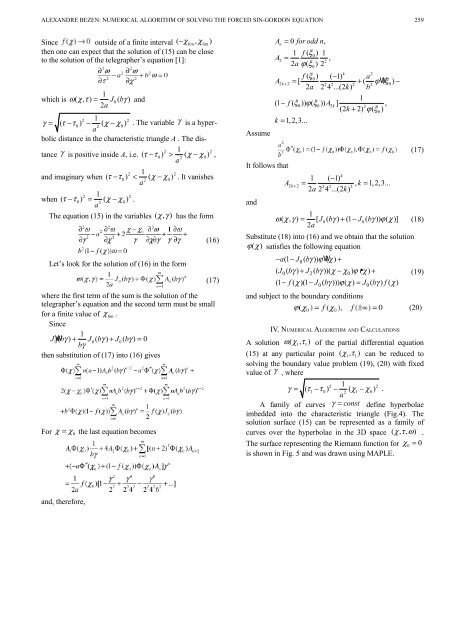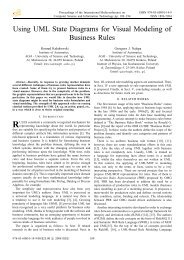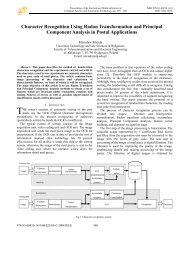Numerical Algorithm of Solving the Forced sin-Gordon Equation
Numerical Algorithm of Solving the Forced sin-Gordon Equation
Numerical Algorithm of Solving the Forced sin-Gordon Equation
Create successful ePaper yourself
Turn your PDF publications into a flip-book with our unique Google optimized e-Paper software.
ALEXANDRE BEZEN: NUMERICAL ALGORITHM OF SOLVING THE FORCED SIN-GORDON EQUATION 259Since outside <strong>of</strong> a finite interval ( − χlim , χlim)<strong>the</strong>n one can expect that <strong>the</strong> solution <strong>of</strong> (15) can be closeto <strong>the</strong> solution <strong>of</strong> <strong>the</strong> telegrapher’s equation [1]:1which is ω( χ, τ ) =0( )2aJ b γ and2 12γ = ( τ −τ 0) − ( χ − χ2 0) . The variable γ is a hyperbolicdistance in <strong>the</strong> characteristic triangle A . The dis-atance γ2 12is positive inside A, i.e. ( τ − τ0) > ( χ − χ2 0) ,a2 12and imaginary when ( τ − τ0) < ( χ − χ2 0) . It vanishesa2 12when ( τ − τ0) = ( χ − χ2 0) .aThe equation (15) in <strong>the</strong> variables ( χ, γ ) has <strong>the</strong> formLet’s look for <strong>the</strong> solution <strong>of</strong> (16) in <strong>the</strong> form(16)(17)where <strong>the</strong> first term <strong>of</strong> <strong>the</strong> sum is <strong>the</strong> solution <strong>of</strong> <strong>the</strong>telegrapher’s equation and <strong>the</strong> second term must be smallfor a finite value <strong>of</strong> χlim .Since1J0 ( bγ ) + J0 ( bγ ) + J0( bγ) = 0bγ<strong>the</strong>n substitution <strong>of</strong> (17) into (16) givesFor χ = χ0<strong>the</strong> last equation becomesAssumeA = 0 for odd n,AAnIt follows thatand1 f ( ξ ) 1=,02 22 a ϕ( ξ0) 2f ( ξ ) ( −1)a= [ + ( ( ) −2a 2 4 ...(2 k)bk202k+ 2ϕ ξ2 2 2 2 01(1 − f ( ξ0 )) ϕ( ξ0 )) A2 k] ,2(2k+ 2) ϕ( ξ )k = 1,2,3...Ak1 ( −1)= , k = 1,2,3...2a2 4 ...(2 k)2k+ 2 2 2 20(17)1ω( χ, γ ) = [ J0 ( bγ ) + (1 − J0( bγ )) ϕ( χ)](18)2aSubstitute (18) into (16) and we obtain that <strong>the</strong> solutionϕ( χ ) satisfies <strong>the</strong> following equation−a(1 − J ( bγ )) ϕ ( χ)+0( J ( bγ ) + J ( bγ ))( χ − χ ) ϕᄁ( χ)+0 2 0(1 − f ( χ )(1 − J ( bγ ))) ϕ( χ) = J ( bγ ) f ( χ)0 0and subject to <strong>the</strong> boundary conditionsIV. NUMERICAL ALGORITHM AND CALCULATIONS(19)(20)A solution ω( χ1, τ1)<strong>of</strong> <strong>the</strong> partial differential equation(15) at any particular point ( χ1, τ1)can be reduced tosolving <strong>the</strong> boundary value problem (19), (20) with fixedvalue <strong>of</strong> γ , where2 12γ = ( τ1 −τ 0) − ( χ2 1− χ0) .aA family <strong>of</strong> curves γ = const define hyperbolaeimbedded into <strong>the</strong> characteristic triangle (Fig.4). Thesolution surface (15) can be represented as a family <strong>of</strong>curves over <strong>the</strong> hyperbolae in <strong>the</strong> 3D space ( χ, τ , ω ) .The surface representing <strong>the</strong> Riemann function for χ0= 0is shown in Fig. 5 and was drawn u<strong>sin</strong>g MAPLE.and, <strong>the</strong>refore,




